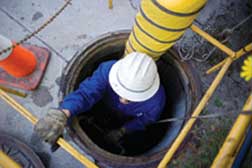Confined-Space Work Rule Upsets Small Contractors
 Contractors say rule is too complicated.
|
Utility contractors have sounded alarm bells about a proposed Occupational Safety and Health Administration rule for construction in confined spaces. Contractors and associations say the proposed rule, issued unexpectedly on Nov. 28, will make it more costly and confusing to work in spaces such as trenches or manholes.
One of the biggest concerns is that the proposed rule was issued without notice during the holidays. Comments were initially due Jan. 28, but after pleas from the National Utility Contractors Association, the National Homebuilders Association and others, OSHA will now take comments through Feb. 28.
“It was almost like they were trying to slide it by,” says Lyle Schellenberg, president of Armadillo Underground Inc., Salem, Ore. “If we get some good comments, then maybe we can take the edge off some of this stuff.”
The rule changes classifications that have been used by the industry, and it is now unclear which classification should be used at which site, says George Kennedy, NUCA vice president of safety. “To many people it’s very confusing,” he says.
An OSHA spokesman could not address the timing of the proposed rule. All comments sent to OSHA have criticized the rule or asked for an extension.
OSHA started work on the rule in 1993 after industry asked for clarification regarding construction in confined spaces. The previous OSHA education and training offered minimal guidance, and most contractors have been using the general industry standard, contractors say. OSHA says the new rule will almost eliminate the six fatalities and all but 10% of the 967 injuries occurring each year to workers in confined spaces.
Schellenberg is still reviewing the rule, which sets up four classifications for confined spaces: isolated-hazard confined space, controlled-atmosphere confined space, permit-required confined space, and continuous system-permit-required confined space. The rule also puts all liability on the primary contractor.
The Engineering and Utility Contractors Association’s Ted Saito said in his comments to OSHA that items in the rule, such as requiring early warning systems, reevaluation of procedures, additional reassessment requirements in the event of an emergency or ventilation failure “will cause an enormous amount of record keeping for training...that will result in financial hardship to all employers without increasing employee safety.
People may choose to simply ignore the rule rather than try to understand it, says L.D. Alexander, safety director of Albuquerque-based RMCI Inc.
The rule also requires that a rescue team be on standby in some instances. Kennedy says those costs are prohibitive to most small contractors. “More emphasis should be put on prevention than rescue after the fact,” he says.
